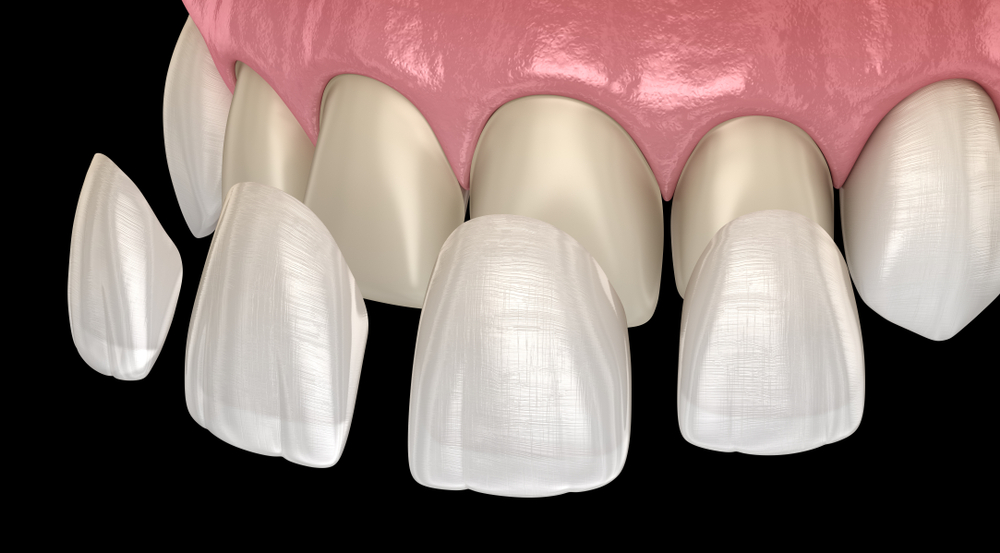The value of the veneer
Featured Products Promotional FeaturesPosted by: Dental Design 22nd February 2024

Overcoming the challenges of composite veneers
One of the most requested cosmetic dental procedures is veneers.[i] Since the pandemic- activated ‘Zoom boom’, patient appetite for such enhancing ‘tweakments’ has grown. Combined with the omnipresent social media of celebrities and influencers sharing their latest Hollywood smiles, the public’s dental aspirations for a brighter, whiter smile have really come into their own.
It’s not all plain sailing however. When Lily Lindsay splashed out £1,000 on her dream smile last summer, little did she realise that she would suffer an allergic reaction to her composite veneers.[ii] Two weeks after what appeared to be a successful treatment, she started suffering unpleasant symptoms including an unsightly and uncomfortable skin rash.
Lily’s reaction was rare but there are other challenges that patients need to be made aware of when it comes to this popular option for enhancing dentition too. One of the main challenges of composite veneers is their susceptibility to staining.[iii] Unlike porcelain veneers, which have a smooth and non-porous surface, composite veneers are more porous,[iv] making them more prone to discolouration over time.
Common staining agents, such as coffee, tea, red wine, and tobacco, can penetrate the porous surface, leading to a dull and discoloured appearance. It is therefore important for patients with composite veneers to be cautious of their dietary and lifestyle choices to minimise the risk of staining. Dental professionals should encourage regular, professional cleanings and the use of whitening toothpaste to help maintain the brightness of composite veneers.ii
Wear and tear
Another consideration when it comes to composite veneers is their durability.[v] While they are generally strong and resilient, composite veneers are not as strong or long-lasting as porcelain veneers. Composite material is more susceptible to wear and tear, making it more prone to chipping or cracking, especially in individuals who grind or clench their teeth. Additionally, composite veneers may need to be replaced more frequently compared to porcelain veneers, which can ultimately increase the overall cost of treatment.[vi]
Maintenance and care are additional issues associated with composite veneers. While they are less invasive and reversible compared to other dental treatments, they still require regular maintenance. Good oral hygiene practices, such as brushing and interdental cleaning, are essential to prevent plaque build-up and gingivitis. Another downside of some dental composites is that they accumulate more biofilms and plaque than other restorative materials and pose the problem of recurrent caries along the tooth-composite interfaces over time.[vii]
Patients with composite veneers should be advised to avoid biting on hard or sticky foods that can cause damage to their veneers. If a composite veneer chips or becomes dislodged, it will be need to be repaired, contributing to additional time and cost.[viii]
A fine art
Composite veneers also require a high level of skill and artistry. Achieving a natural and aesthetically pleasing result with composite veneers is a complex process that demands meticulous attention to detail. The dental professional must carefully match the colour of the composite resin to the natural shade of the patient’s teeth, ensuring a seamless blend and an overall natural appearance – bearing in mind that the patient’s level of satisfaction may not be the same as that of the dentist. A good understanding of colour and shade determination is essential. Human dentition shades differ significantly, and electronic devices can identify approximately 100,000 dental shades while the human eye can identify only 1% of these shades.[ix]
It requires expertise in sculpting and shaping the material to create a harmonious smile too. The success of composite veneers relies heavily on the skill and experience of the dentist, making it vital they choose a qualified professional for the procedure. Having your skills validated by a respected industry association is a stamp of approval that not only boosts personal confidence but also enhances your professional reputation.
Membership of the British Academy of Cosmetic Dentistry (BACD), a world-leading authority on ethical cosmetic dentistry, gives dental professionals access to an Accreditation programme that requires them to hone and demonstrate their skills in functional aesthetic dentistry. Suitable for both clinicians and laboratory technicians, the process involves the submission of clinical cases, in categories that include smile makeover, indirect shade matching, tooth replacement, posterior restoration, complex composite bonding, periodontal plastic surgery, minimally-invasive techniques and complex whitening. BACD Accredited status sets members apart and validates the extent of their competence to patients.
Composite veneers offer a convenient and affordable option for patients seeking to improve their smile. However, there are challenges associated with this treatment: the vulnerability to staining, the need for regular maintenance and replacement and the skill required for a natural result. Carefully assessing a patient’s needs and expectations can help dental professionals determine the best treatment option for achieving that longed-for, beautiful and lasting smile.
For further enquiries about the British Academy of Cosmetic Dentistry visit www.bacd.com
[i] Oral Health Foundation https://www.dentalhealth.org/news/implants-and-veneers-top-list-of-nations-oral-health-questions
[ii] Mirror newspaper 30 August 2023 https://www.mirror.co.uk/news/health/allergic-reaction-veneers-leaves-woman-30819768
[iii] Pini NP, Aguiar FH, Lima DA, Lovadino JR, Terada RS, Pascotto RC. Advances in dental veneers: materials, applications, and techniques. Clin Cosmet Investig Dent. 2012 Feb 10;4:9-16. doi: 10.2147/CCIDEN.S7837. PMID: 23674920; PMCID: PMC3652364. [Accessed November 2023]
[iv] Alkhubaizi Q, Alomari Q, Sabti MY, et al. Effect of Type of Resin Composite Material on Porosity, Interfacial Gaps and Microhardness of Small Class I Restorations. J Contemp Dent Pract 2023;24(1):4–8. https://www.thejcdp.com/doi/JCDP/pdf/10.5005/jp-journals-10024-3458 [Accessed November 2023]
[v] Mazzetti T, Collares K, Rodolfo B, Antônio da Rosa Rodolpho P, Hélène van de Sande F, Sérgio Cenci M,10-year practice-based evaluation of ceramic and direct composite veneers, Dental Materials, Volume 38, Issue 5, 2022, Pages 898-906, ISSN 0109-5641, https://doi.org/10.1016/j.dental.2022.03.007.
[vi] Alothman Y, Bamasoud MS. The Success of Dental Veneers According To Preparation Design and Material Type. Open Access Maced J Med Sci. 2018 Dec 14;6(12):2402-2408. doi: 10.3889/oamjms.2018.353. PMID: 30607201; PMCID: PMC6311473. [Accessed November 2023]
[vii] Zhang N, Melo MAS, Weir MD, Reynolds MA, Bai Y, Xu HHK. Do Dental Resin Composites Accumulate More Oral Biofilms and Plaque than Amalgam and Glass Ionomer Materials? Materials (Basel). 2016 Nov 1;9(11):888. doi: 10.3390/ma9110888. PMID: 28774007; PMCID: PMC5457238. [Accessed November 2023]
[viii] Pini NP, Aguiar FH, Lima DA, Lovadino JR, Terada RS, Pascotto RC. Advances in dental veneers: materials, applications, and techniques. Clin Cosmet Investig Dent. 2012 Feb 10;4:9-16. doi: 10.2147/CCIDEN.S7837. PMID: 23674920; PMCID: PMC3652364. [Accessed November 2023]
[ix] Alnusayri MO, Sghaireen MG, Mathew M, Alzarea B, Bandela V. Shade Selection in Esthetic Dentistry: A Review. Cureus. 2022 Mar 20;14(3):e23331. doi: 10.7759/cureus.23331. PMID: 35464532; PMCID: PMC9015060. [Accessed November 2023]









